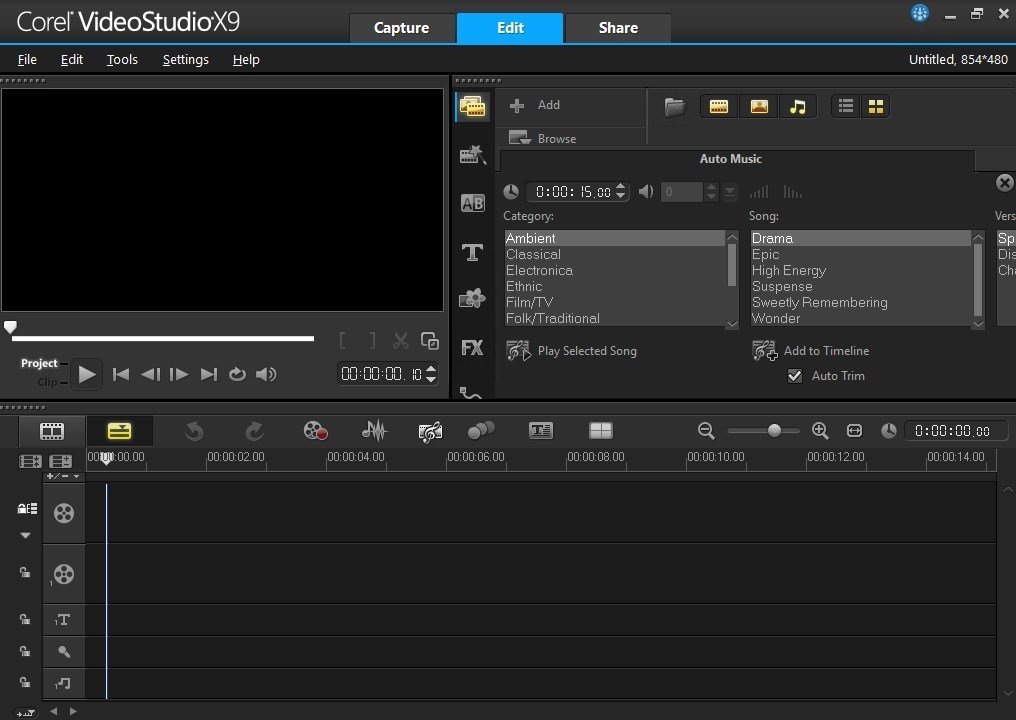

The program allows users the same steps as prosumer and professional editors and many of the same effects. The VideoStudio is an enjoyable to use nonlinear editor for the average home video hobbyist. You can also add music directly from a CD by using the CD-ROM in your computer.įinishing the program renders all of the files you created and makes a finished AVI file of your movie. WAV audio files, so you can create voiceovers and other audio with your sound card. Once again, adding audio is just a matter of dragging and dropping a clip from the library or by using the add media button and adding files directly. There are two tracks of audio on the timeline, one for voice and one for background music. Also available are easy-to-use motion options. By simply pressing buttons, you have all the usual text controls, including bold, italic, underline, justify, font size and color. VideoStudio will use any TrueType font installed on your computer. We clicked the Title option, moved to the clip on the timeline that we wanted to superimpose the graphic onto, then just typed the title in the preview window. The program gives a graphic display of what the effect will look like, both in the library and on the timeline (or storyboard). Just pick an effect from the library, drag it to the timeline and drop it between two clips. The effects range from simple fades and wipes to high-quality explosions and 3D effects. Drawing on its experience with the MediaStudio line of nonlinear editing software, Ulead has included numerous transition effects with VideoStudio 3.0. This can save a bit of time when you have a finished clip ready to be dropped into the timeline.Īfter putting our clips in order and trimming them, we were ready to add effects. To the right of the timeline is a button that opens the file directories on your computer and will allow you to add new clips directly into the timeline without first loading them into the library. The clips were easy to view and trim by just double clicking on them, either on the timeline or in the library. From there, we just dragged the shots we wanted into the timeline in the order we wanted. We opened the list and our clips appeared in the library. Ulead suggests making a rough cut of your show in Video Wizard and then importing it to VideoStudio to add effects, graphics and audio.Īfter capturing our footage, we opened VideoStudio and the file names of the footage we just captured were listed in the Recent File list. The Video Wizard is a very simple capture and editing program. Of course, the capture quality will depend on the capture board installed in your system. To solve the problem, we went to the companion Video Wizard program (installed with VideoStudio) and easily captured our footage as an MJPEG file at 704×480 with a 6.6:1 compression ratio (which was the highest offered).
#ULEAD VIDEOSTUDIO FREE FULL#
We looked over the list and noticed that none of the choices were full screen (the largest available was 352×240 at 29.97 fps). When we opened VideoStudio and started a new project to capture video, the program asked us to select a project template. Installation was very simple and took about 10 minutes. We tested the program with the Matrox Rainbow Runner, which was already installed on our system (a 133MHz Pentium with 32MB of RAM and a Seagate Cheetah wide SCSI-2 hard drive for video capture). According to Ulead, VideoStudio will work with any capture boards. You must have a video capture board already installed to get your footage into your computer. This presents a nice, intuitive way to organize your editing tasks. As you press each button, the GUI changes to offer the options related to that task.

Across the top are buttons corresponding to the steps you take to produce your show (Start, Capture, Storyboard, Effects, Title, Voice, Music, and Finish). The top two thirds is divided into a nice, fairly large preview screen in the center with an options panel on the left and the library on the right. We found ourselves using the timeline function most of the time, though. The timeline can be changed to a storyboard view, which makes the program a bit more versatile. VideoStudio 3.0’s interface has a timeline on the bottom third of the screen. The program includes many digital and 3D effects, animated titles and separate audio tracks for voice-over and background music. Not to be outdone, Ulead has released VideoStudio 3.0, a low-cost nonlinear editing program aimed at just that market.Īimed at the beginner and casual hobbyist, VideoStudio 3.0 has a nicely designed GUI (graphic user interface), as well as all of the features necessary to create a smooth, professional-looking video.

Many of the new, low-cost nonlinear editing programs are aimed at the home video hobbyist. Nonlinear editing is becoming more popular everyday, which means prices are dropping and new programs are arriving.


 0 kommentar(er)
0 kommentar(er)
